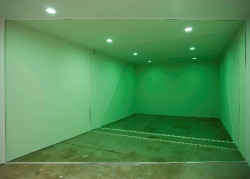It was with great pleasure that I interviewed Marcius Galan, a Brazilian artist that left me overwhelmed by the array of works he presented at White Cube Bermondsey.
The exhibition Geometric Progressions will be on until September 29.
Enigmatic, enlightened, the words I choose to describe are somewhat on the verge of the metaphysical. The way he plays with our mind to bring out codes that are so present that become hidden. How his works bare the different levels of relationships between the personal and the world in minimalist, abstract forms. All with impeccable finishing. He marked his presence in biennials, art fairs and important institutions around the world. In the highpoint of his career, the best is still to come.
What inspires you in life or in the works of other artists?
My work absorbs a lot of what I have as relationships with the common, day-to-day life. My relationship with architecture, with space, with the simplest things and the most complicated things as well, for example trying to resolve bureaucratic problems. All these things come into my works in different ways. But in general I think my work goes a lot in the direction of our relationship with functionality and precision, and with the idea of representation. These three things may seem a little different, but at the same time they are connected by the questioning of how we relate to functional things, how we try to represent things through precision and how Science enters as intermediary on this relationship of man and world, and how experience sometimes is very far from Science and representation. Sometimes in the simplest things, like trying to understand how can we organise ourselves in society. I think human relations are dependent on this grid that limits what you can do, in everything, architecture, graphic design, etc.
Yes, it exists in many different levels. I can’t help imagining how your mind operates. I picture you seeing the world as different systems. After I began to study your work this kind of vision got to me, and the world revealed itself as a whole systematical dynamics.
Unfortunately I arrived a little bit late to your presentation at Gasworks, could you summarize a little bit of that talk and comment on your work “Bureaucratic Abstractions”?
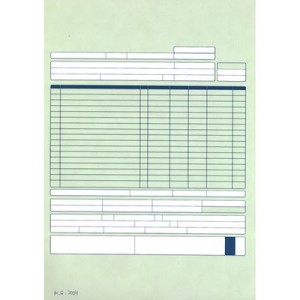
It is a work from 2004. It started while I was exhibiting in a commercial gallery in São Paulo and it was my first solo show. Its origin are the invoices and spreadsheets and it refers to the idea of market. I still did not know what to expect from this relationship. So I thought about how we associate to abstraction and to geometric constructions when the information is removed from this system, so you get just the grids of the spreadsheet and that becomes a completely abstract thing.
The title of the work bears an ironic tone because if you think of the tradition of abstraction coming from post-war America, its all about a higher meaning, the sublime, trying to find the essence of art. For me, abstraction always had this concern. In this work I use a banal element, with no artistic feature, a completely despicable bureaucracy. It makes you think of the relation with these forms in both ways and how you are surrounded by this day-to-day geometry all the time.
Another thing that I thought is that these forms, in Architecture as in bureaucratic papers, take you through paths that usually lead to nowhere. So bureaucracy is an attempt to organise but sometimes it can be used as a way to hide erroneous or illegal actions. It made me think of situations like with money, you pay taxes but you don’t know exactly where it goes.
It all becomes abstract. It is very interesting how this relationship, this paradox even – between abstraction/ the absolute versus human relations/ the personal – permeates all your work.
Following this theme, you have another work where you use maps and try to bring the point in the map into reality to show how these abstract representations are brought into your life without loosing their virtual figure. So they exist in your life, they are part of your life, but they are not physical, so they can be illusions.
The maps also outline the idea of space, of limits, like the paper plane that is a surface that you relate to all the time, and on to the architectural level of space and the intention to organise it. They are different scales of the same idea of diagram. Social diagram is an attempt to organise social relationships of people on the same space and how this has a weight and intensity, an intention to direct the ways people are going to follow on these spaces, even to manipulate them or to try to make things function in a better way. These drawings are representations that can lead to directing the way we live.
On the maps these representations come from the idea of scale. My work for the São Paulo Biennial, where I tried to create in real size the dot on a map, my intention was to use two different scientific understandings to create a paradox, an impossible situation. An unreal situation but that respects the norms of these different fields that occur parallel to each other but reach an unpractical condition. The representational system is always imprecise; you will never be able to reach reality’s true representation with an absolute mechanism, because that would be reality and not representation after all.
Like in Jorge Luis Borges’s short story On Exactitude in Science, that narrates the tale of cartographers so obsessed with precision that they create a map with a 1:1 scale. To see the point on the map you would need to go exactly to the place. So in the end, there is no need for representation because it becomes reality itself. The mathematical point, which you can break up into the infinite, is just a rule that you believe in and use it as truth, but it is imprecise. These gaps between these comprehensions, of sciences that call themselves precise, are what interest me. Our relationship with space and the world through these gaps they leave behind.
Even if these mathematical points do not have a real, material existence, we assign a certain value and it becomes real for us, it becomes part of our reality. The same with the geometrical representations, our imagination follows these patterns and we can see it in our minds. Like, for example, the work you showed at In Lines and Realignments, at Simon lee Gallery, London, with the nails that form almost a line, and the shadow of the nails completes the lines. Do you rely on these pre-established, mental models that people have to complete the work of art?
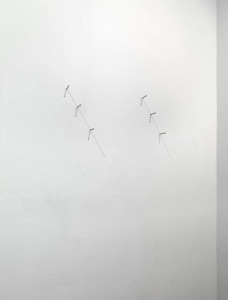

It sure is great when that happens because it is a factor that always interests me. For example “Three Sections”, the actual piece is not the materials, the light, the room, but the viewer’s perception. The action of constructing in your mind the division of space, it is a vision that actually does not exist. This piece is different from the others, it was something new for me to question the viewer’s perception in relation to space in this sense, a piece that asks the viewer to touch it to test if it is real or not.
I find it very interesting how in your work we can go from the illusion of a bureaucratic or diagrammatical representation to the illusion of perception, of perspective.
The illusionism is always something that comes up when talking about this work. But for me the illusionistic part is not the important part, even more because after the first time you experience the work you are not fooled by it anymore, you break the illusion and then go back to it and that is something that bothers you, so you stay in the border between illusion and perception. Doubt is the most important thing in this work, you doubt your perception, it does not conclude itself.
When I experienced this piece at the White Cube show “Geometric Progression”, the idea of how after discovering the trick the illusion is broken came to my mind, and I pondered about your intentions. Do you, like an illusionist, rely on what the audience will see to create the trick, or do you, like minimalists, let it open to the viewer’s subjective participation?
That is something that I question myself as well, you have to go out of your own ego and try to see from the other’s perspective. I did not know how it would happen to people but I could feel that by constructing it in that way some people could share the same perception. I did not use any scientific formula or technological artifice for that. It is very simple and at the same time very fragile, it can be perceived in many ways and that is were the strength of the work lye, to be able to create an element on space that exists in the mind of the viewer, with no advanced technology.
You touched on a point that I believe is the greatest force in your work, and that is the essence of everything we relate to, the dichotomy of the personal versus the absolute. This paradox is present in your art as in life. You can lead people to a perception, a code, that everyone lives by but at the same time everyone experiences it personally. ç
So, in the case of “Parallels” or “Bunting” where you use a specific material to play with the viewer’s perception, testing it by producing forms that seem light with heavy materials, etc; Your intention is to provoke the viewer’s perception based on a code or experience that you know they will have?
Yes, in these works the firmness of the material and its counterpart, the idea of elasticity, that it suggests is very interesting. For example, with “Isolators”, for me it related to the construction of space, to delimitate space. Based on the cords used to isolate spaces on the street, etc. As the viewer gets closer they realise the strips are rigid and it becomes almost a demarcation of its own space. Then the piece starts to bear a presence and it sustains an existence in itself, like a sculpture.
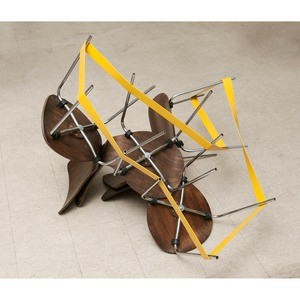
Coming back to the universal versus personal, I think every viewer will be able to complete the square in “Expanded Square” as a projection of their mind, but it the case of “Immobile/Unstable” everyone can see the balance and equilibrium of the piece but there is the one-pound coin that bears all that weight, so there is obviously a political connotation behind.
This works plays with the idea of equilibrium and stability/instability. It is a mobile so its function is that of movement, but it is stable because it touches the floor. When I did it I thought about the economic instability the world was going through and also how in Brazil we were starting to enter an economically stable period while in the rest of the world there was crisis. But it was a growth situation based on crooked foundations, like the wooden pieces on the work, an educational system that doesn’t work, an unequal social structure, etc. Not that this piece is an allegory of this situation. It is a site-specific piece, when I use the one-pound coin it relates to the UK.
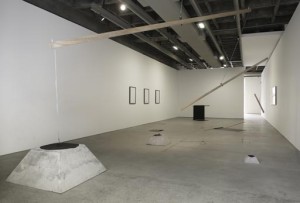
And how was your residency period in London? What did it mean for your career?
It was a very fortunate coincidence that I got the residency at Gasworks and the exhibition at White Cube at the same time. I had passed by the Mercosul and São Paulo Biennial, which were really important for my career and started to exhibit in institutions outside Brazil, that was something very different for me at the time when I was used to exhibit my work in commercial galleries. It was interesting because I could start producing works and see how they related between themselves, while in a gallery it was hard to get a panorama like this. Also, I was able to start experimenting as well; you can start to produce larger works. Then I was nominated for the Pipa Prize and got the residency at Gasworks. White Cube had already invited me so it was great to be able to use the residency to plan some works while producing other works for the exhibition.
The exhibition at White Cube was amazing. I also liked the fact that you exhibited alongside Sarah Morris, she with a work made in Brazil and you with works made in London. How did you feel about that?
It was a great connection. There are many interesting coincidences in relation to geometry that can be seen on both works that I felt really happy to see alongside one another.
And what are your future projects?
In September I will install the first version of “Immobile/Unstable” at Inhotim, which will open in October. I will have a show Espacio NC Bogotá, which I have already started to plan and produce, also in October. I will be in a group show in Amsterdam and my works will be on the 30 years of the São Paulo Biennial.
Very well! Thank you

